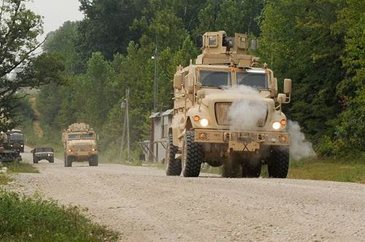By James Van Howe
 From Joint IED Defeat Organization (JIEDDO) https://www.jieddo.dod.mil. Soldiers from the 713th Engineer Company, out of Valparaiso, Ind., conducted counter improvised explosive device training at Camp Atterbury Joint Maneuver Training Center Aug. 20. Photo by Staff Sgt. Matthew Scotten.
From Joint IED Defeat Organization (JIEDDO) https://www.jieddo.dod.mil. Soldiers from the 713th Engineer Company, out of Valparaiso, Ind., conducted counter improvised explosive device training at Camp Atterbury Joint Maneuver Training Center Aug. 20. Photo by Staff Sgt. Matthew Scotten.
This post originally appeared on Jim’s CLEO blog and is reproduced with permission from the author.
The panelists from Tuesday’s 2:00 pm Market Focus, Defense: Laser Interrogation for Standoff Detection of Hazardous Materials, presented the audience with a difficult problem to which the U.S. Department of Defense is allocating many resources and substantial funding:
How can you accurately detect threats from chemical, biological, radiological, nuclear, or high-yield explosives (CBRNE) from a safe stand-off distance to protect or warn those in harms way?
Laser spectroscopy is the short answer, be it UV Raman, NIR Raman, Long Wave Absorption Spectroscopy, Laser-induced Breakdown Spectroscopy (LIBS), Photoacoustice Spectroscopy, Ultrafast Spectroscopy, just to name a few. However, what kind of spectroscopy you use to identify a threat is just the beginning to making a system that can function in rugged battlefield environments and accurately deliver the information you need in the time you need it.
Panelist Scott Robertson, Research Senior Manager at Lockheed Martin, posed just how difficult this can be with some specific targets of the type of systems needed in the field. One project whose objective was to analyze threats by the vapors and residues from vehicles needed a stand-off detection distance of 400 m, an entire scan, detect and process time of 1.0 second, with a false alarm rate of only 1 in one million, and packaged in a volume of 1 cubic meter. Another specification target was to be able to scan an area of 2,700 square meters per second while searching a road 100 m wide, while traveling 60 mph.
There are other constraints as well. Tom Stark (no relation to Tony from the Iron Man series), from Landmark Technologies Joint IED Defeat Organization, reminded the audience that 99.9% of the people in an area you want to scan are not the threat. You can’t and don’t want to blatantly scan a crowd with a potentially dangerous high-power laser system. Another constraint therefore is laser safety, particularly eye safety. Add this to the checklist of specification targets and you start bumping up against fundamental limits for power needed to detect a spectroscopic signature of a threat, as well as selectivity and sensitivity for identification of molecules.
Augustus Fountain, Senior Research Scientist in Chemistry at Edgewood Chemical Biological Center, spoke to some of these issues. Fountain spoke about choosing the wavelength/spectroscopic for your method. In the UV you gain in sensitivity but loose in selectivity. The opposite is true as you move into the IR. Another problem to consider in system design is 1/r2 loss and atmospheric attenuation. What kind of time window do you have available for scanning? Is the analyte a mixture of compounds- harder to detect spectroscopically, or something simple? Scott Roberston echoed many of these remarks. Do you want to identify the threat or do you just want to know if it is going to kill you? The specific use and system dictate different constraints on what you design. Robertson also argued most users want the latter- “just give me a green or red light,” not a beautiful Raman spectrum that requires interpretation. More often you just want to know “threat or no threat” for fast decision making in an environment of potential threats…
(To find out some of the specific lasers needed for current standoff-detection projects, more system requirements, and to read the entire post, click here)
Posted: 10 May 2012 by
James Van Howe
| with 0 comments